Tag: 2017 source edit |
No edit summary Tag: 2017 source edit |
||
| (166 intermediate revisions by the same user not shown) | |||
| Line 1: | Line 1: | ||
{{DISPLAYTITLE:<span style="position:absolute; top:-9999px;">PCBaller World/</span>North Germany}}__NOINDEX__ | |||
{{PCBallerInfobox | {{PCBallerInfobox | ||
|title = North German People's State<br><small>''Norddeutscher Volksstaat''</small> | |title = North German People's State<br><small>''Norddeutscher Volksstaat''</small> | ||
| Line 7: | Line 8: | ||
|caption = | |caption = | ||
|motto = "Frieden, Freiheit, Volk, Naturverbundenheit"<br><small>"Peace, Freedom, Nation, and connection to nature"</small> | |motto = "Frieden, Freiheit, Volk, Naturverbundenheit"<br><small>"Peace, Freedom, Nation, and connection to nature"</small> | ||
|anthem = [ | |anthem = [[PCBaller World/North Germany/Lied vom Vaterland|Lied vom Vaterland]] | ||
|population = [[File:DownArrow.png]] 8,948,945 | |population = [[File:DownArrow.png]] 8,948,945 | ||
|capital = | |capital = | ||
| Line 15: | Line 16: | ||
|system = [[Federalism|Federal]] [[Parliamentarianism|parliamentary]] [[Democratic Socialism|socialist]] [[Republicanism|republic]] | |system = [[Federalism|Federal]] [[Parliamentarianism|parliamentary]] [[Democratic Socialism|socialist]] [[Republicanism|republic]] | ||
|legislature = [[PCBaller World/North Germany/Reichstag|''Reichstag'']] | |legislature = [[PCBaller World/North Germany/Reichstag|''Reichstag'']] | ||
|leaders = *'''President:''' ⠀⠀⠀⠀⠀⠀⠀⠀⠀⠀ [[File: | |leaders = *'''President:''' ⠀⠀⠀⠀⠀⠀⠀⠀⠀⠀ [[File:Soc.png]] JC | ||
|land = 117,749 km² | |land = 117,749 km² | ||
|sea = | |sea = | ||
| Line 22: | Line 23: | ||
*[[File:UFNNS.png]] [[PCBaller World#Union of Free Nations on the North Sea|UFNNS]] | *[[File:UFNNS.png]] [[PCBaller World#Union of Free Nations on the North Sea|UFNNS]] | ||
*[[File:Uninat.png]] [[PCBaller World#Nationalist International|Nationalist International]] | *[[File:Uninat.png]] [[PCBaller World#Nationalist International|Nationalist International]] | ||
|founded = 2026 | |founded = March 2026 | ||
|currency = | |currency = | ||
|hdi = [[File:DownArrow.png]] 0.888 | |hdi = [[File:DownArrow.png]] 0.888 | ||
| Line 28: | Line 29: | ||
|gdppc = | |gdppc = | ||
|religions = | |religions = | ||
|ethnic = 97.1% [[wikipedia: | |ethnic = 97.1% [[wikipedia:de:Deutsche|German]]<br> | ||
1.2% [[wikipedia:Frisians|Frisian]]<br> | 1.2% [[wikipedia:Frisians|Frisian]]<br> | ||
1.1% [[wikipedia:Poles|Polish]]<br> | 1.1% [[wikipedia:Poles|Polish]]<br> | ||
| Line 44: | Line 45: | ||
}} | }} | ||
{{Bold|North Germany}}, officially the {{Bold|North German People's State}} ''([[wikipedia:German language|German]]: Norddeutscher Volksstaat)'' is a northern-central European country that emerged out of the collapse of Germany and currently stands in as the de facto replacement of the German nation-state, especially on the international stage. Though it is highly isolationist, it is a member of the [[File:AltUnball.png]] [[PCBaller World#AltUN|AltUN]] as well as a founding member of the [[File:UFNNS.png]] [[PCBaller World#Union of Free Nations on the North Sea|UFNNS]] and [[File:Uninat.png]] [[PCBaller World#Nationalist International|Nationalist International]], two organisations dedicated towards preserving national sovereignty internationally. The state possesses multiple nuclear weapons as well as a extensive fallout shelter network. | {{Bold|North Germany}}, officially the {{Bold|North German People's State}} ''([[wikipedia:German language|German]]: Norddeutscher Volksstaat)'' is a northern-central [[PCBaller World/Europe|European]] country that emerged out of the [[PCBaller World/German Collapse|collapse of Germany]] and currently stands in as the de facto replacement of the German nation-state, especially on the international stage. Though it is highly isolationist, it is a member of the [[File:AltUnball.png]] [[PCBaller World/Factions#AltUN|AltUN]] as well as a founding member of the [[File:UFNNS.png]] [[PCBaller World/Factions#Union of Free Nations on the North Sea|UFNNS]] and [[File:Uninat.png]] [[PCBaller World/Factions#Nationalist International|Nationalist International]], two organisations dedicated towards preserving national sovereignty internationally. The state possesses multiple nuclear weapons as well as a extensive fallout shelter network. | ||
North Germany's population is in intentional rapid decline. North Germany implemented depopulation programs to not only reduce the amount of ethnic diversity in the state, but also lower the overall population in order for the envisioned rural and semi-neoluddist system, the government imagines, to take hold. | North Germany's population is in intentional rapid decline. North Germany implemented depopulation programs to not only reduce the amount of ethnic diversity in the state, but also lower the overall population in order for the envisioned rural and semi-neoluddist system, the government imagines, to take hold. | ||
| Line 56: | Line 57: | ||
North Germany as of today, has undergone extreme societal, demographic, and cultural change; and faced many hardships during said periods. North Germany has held two elections since independence, and achieved great progress towards the goals of the leading party. | North Germany as of today, has undergone extreme societal, demographic, and cultural change; and faced many hardships during said periods. North Germany has held two elections since independence, and achieved great progress towards the goals of the leading party. | ||
== {{Bold|Geography}} == | |||
The geography of North Germany is characterized by the [[w:North German Plain|North German Lowland]], being incredibly flat and having no real mountains; it includes marches, the geest, and heaths. Today, North Germany is notable for its high forest coverage through a long and ongoing reforestation campaign by the Government, most of North Germany's area is still covered in fields and grasslands however. | |||
The land area of North Germany is roughly 117,749 km², and the central point of the state lies in Mecklenburg at 53.490514, 12.244842. | |||
North Germany is a very rural country. | |||
=== {{Bold|Political Geography}} === | |||
The North German state is subdivided into five levels. | |||
[[File:NG Federalism.png|thumb|Federal structure of the<br>North German People's State|240px]] | |||
{| class="wikitable" | |||
! Name !! Purpose !! Level | |||
|- | |||
| '''State''' || Federal state || First-level administrative division | |||
|- | |||
| '''District''' || Regional authority and governance || Second-level administrative division | |||
|- | |||
| '''Amt''' || Collective municipalities || Third-level administrative division* | |||
|- | |||
| '''Municipality''' || Municipal-level governance || Third-level administrative division | |||
|- | |||
| '''Regional''' || Sub-municipal governance || Fourth-level administrative division | |||
|- | |||
| '''District/Village''' || Ultralocal supervision || Fifth-level administrative division | |||
|- | |||
| colspan=3 style="background:#424242" | *By common definition, technically inadequate application | |||
|} | |||
#The First-level administrative divisions are the 21 federal states, 5 of which are autonomous. The federal states take on similar responsibilities from those in the pre-collapse [[File:Cball-Germany.png]] Federal Republic of Germany, while some autonomy, like school and electoral policy, has been either partially for fully stripped from these states in comparison to the FRG-era, the states do have more autonomy in other areas. Autonomous states are largely independent of the federal government in some aspects, however each of which has different regulations and rights/responsibilities. | |||
#The Second-level administrative divisions are the districts, a regional authority which acts as a collection of municipalities, standing above municipal governments in administration but below state governments. These also take on similar tasks to their FRG-era equivalents, mostly retaining to things like vehicle registration, building and zoning regulations, data collection, and fund allocation. Unlike their FRG-era counterparts however, districts in North Germany are responsible for some economic planning. | |||
#In North Germany, there are technically two administrative divisions commonly regarded as Third-level administrative divisions as per common international definition. | |||
##The first one is the ''[[w:Amt|Amt]]'' a type collective municipality that serves as a cooperative union of several, often smaller, municipalities. Unlike most subdivisions in North Germany, this one serves little purpose as it has primarily been kept for traditional reasons, disregarding its lack of real function. Collective municipalities do not have a elected government, instead forming a small coordinative body that only meets rarely and serves primarily cultural, complaint, and cooperation purposes. This body is formed either through a collection of all mayors of the member municipalities, or through pulling a proportional faction percentage from all member municipality's councils. | |||
##The second Third-level administrative division per definition are the municipalities, the most important subdivision in regular North German life. They serve as local governments; taking on municipal, cultural, and administrative tasks as well as some economic planning, zoning, and registration.<br>Municipalities always have a elected council governemnt and mayor. | |||
#Fifth-level administrative divisions are this districts of cities, or villages of municipalities. These divisions always exist, primarily for historical and cultural purposes, however they can form district assemblies of either direct-democratic or elective nature in order to elect a ultralocal village representative and to create a space of public democracy which can most locally plan any developments, ideas, and to some extension, even economics. In some cases, it is possible for these village assemblies to overrule municipal decisions, however this rarely happens for important issues, and if it does, it often leads to a legal dispute. Such overruling is not possible for district assemblies in cities. | |||
Every North German administrative division is guaranteed the right to secession via popular and democratic referendum as per the North German constitution. | |||
==== {{Bold|List of States}} ==== | |||
The North German People's State has a total number of 21 federal states, 5 of which are autonomous - having more administrative freedoms. | |||
Autonomous states are displayed in gold. | |||
{| class="wikitable" style="width: 100%;" | |||
| colspan=6| [[File:North_Germany1.png|904px]] | |||
|} | |||
{| class="wikitable sortable" style="width: 100%;" | |||
|- | |||
! Flag !! Name !! Code !! Capital !! Population !! Leader | |||
|- | |||
| <center>[[File:NG-AL.png|100px]]</center> || Altmark<br><small>''Altmark''</small> || AL || Salzwedel || 193,456 || TBD | |||
|- | |||
| <center>[[File:NG-HB.png|100px]]</center> || Free Hanseatic City of Bremen<br><small>''Freie Hansestadt Bremen''</small> || HB || Bremen || 342,725 || [[File:PCBWFritzRichter.png]] [[PCBaller World/North Germany/People/Fritz Richter|Fritz Richter]] ([[File:Konservpart.png]]) | |||
|- | |||
|style="background:#70664D"| <center>[[File:NG-EF.png|100px]]</center> ||style="background:#70664D"| East Frisia<br><small>''Ostfriesland''</small> ||style="background:#70664D"| EF ||style="background:#70664D"| Leer ||style="background:#70664D"| 254,892 ||style="background:#70664D"| TBD | |||
|- | |||
|style="background:#70664D"| <center>[[File:NG-DI.png|100px]]</center> ||style="background:#70664D"| Peasants' State of Dithmarschen<br><small>''Bauernland Dithmarschen''</small> ||style="background:#70664D"| DI ||style="background:#70664D"| Heide ||style="background:#70664D"| 117,673 ||style="background:#70664D"| TBD | |||
|- | |||
| style="background:#70664D"|<center>[[File:NG-HH.png|100px]]</center> ||style="background:#70664D"| Free and Hanseatic City of Hamburg<br><small>''Freie und Hansestadt Hamburg''</small> ||style="background:#70664D"| HH ||style="background:#70664D"| Hamburg ||style="background:#70664D"| 829,490 ||style="background:#70664D"| TBD | |||
|- | |||
| <center>[[File:NG-HA.png|100px]]</center> || Hanover State<br><small>''Land Hannover''</small> || HA || Hanover || 1,311,438 || TBD | |||
|- | |||
| <center>[[File:NG-HO.png|100px]]</center> || Holstein<br><small>''Holstein''</small> || HO || Kiel || 1,265,276 || TBD | |||
|- | |||
| <center>[[File:NG-HY.png|100px]]</center> || County of Hoya<br><small>''Grafschaft Hoya''</small> || HY || Hoya || 332,714 || TBD | |||
|- | |||
| <center>[[File:NG-KW.png|100px]]</center> || Kehdingen-Wesermünde<br><small>''Kehdingen-Wesermünde''</small> || KW || Vörde || 435,491 || TBD | |||
|- | |||
| <center>[[File:NG-LB.png|100px]]</center> || Landsberg State<br><small>''Landsberg''</small> || LB || Landsberg an der Warthe || 400,875 || TBD | |||
|- | |||
| <center>[[File:NG-HL.png|100px]]</center> || Free and Hanseatic City of Lübeck<br><small>''Freie und Hansestadt Lübeck''</small> || HL || Lübeck || 229,273 || TBD | |||
|- | |||
| <center>[[File:NG-LU.png|100px]]</center> || Lüneburg<br><small>''Lüneburg''</small> || LU || Lüneburg || 523,134 || TBD | |||
|- | |||
| <center>[[File:NG-MK.png|100px]]</center> || Free State of Mecklenburg<br><small>''Freistaat Mecklenburg''</small> || MK || Schwerin || 1,045,801 || TBD | |||
|- | |||
|style="background:#70664D"| <center>[[File:NG-NF.png|100px]]</center> ||style="background:#70664D"| North Frisia<br><small>''Nordfriesland''</small> ||style="background:#70664D"| NF ||style="background:#70664D"| Husum ||style="background:#70664D"| 143,258 ||style="background:#70664D"| TBD | |||
|- | |||
| <center>[[File:NG-OD.png|100px]]</center> || State of Oldenburg<br><small>''Land Oldenburg''</small> || OD || Oldenburg || 234,098 || TBD | |||
|- | |||
| <center>[[File:NG-PO.png|100px]]</center> || March of Pomerania<br><small>''Mark Pommern''</small> || PO || Stettin || 634,423 || TBD | |||
|- | |||
| <center>[[File:NG-PR.png|100px]]</center> || Prignitz<br><small>''Prignitz''</small> || PR || Pritzwalk || 220,355 || TBD | |||
|- | |||
|style="background:#70664D"| <center>[[File:NG-SA.png|100px]]</center> ||style="background:#70664D"| Saterland<br><small>''Saterland''</small> ||style="background:#70664D"| SD ||style="background:#70664D"| Ramsloh ||style="background:#70664D"| 19,546 ||style="background:#70664D"| TBD | |||
|- | |||
| <center>[[File:NG-SL.png|100px]]</center> || Free State of Schleswig<br><small>''Freistaat Schleswig''</small> || SL || Schleswig || 312,352 || TBD | |||
|- | |||
| <center>[[File:NG-UK.png|100px]]</center> || Uckermark<br><small>''Uckermark''</small> || UK || Prenzlau || 102,675 || TBD | |||
|- | |||
|} | |||
== {{Bold|Culture}} == | == {{Bold|Culture}} == | ||
| Line 114: | Line 203: | ||
===== {{Bold|State-sponsored music}} ===== | ===== {{Bold|State-sponsored music}} ===== | ||
[[File:Klublieder.png|thumb|280px|Cover of "Klublieder der Neuzeit"]] | [[File:Klublieder.png|thumb|280px|Cover of "[[PCBaller_World/North_Germany/Klublieder der Neuzeit|Klublieder der Neuzeit]]"]] | ||
The North German state orchestra has been set up primarily to play the National Anthem ([ | The North German state orchestra has been set up primarily to play the National Anthem ([[PCBaller World/North Germany/Lied vom Vaterland|Lied vom Vaterland]]) as well as other official and state-related songs during ceremonies, parades, and other events.<br>It has since branched out however, most notably in the creation of the album "[[PCBaller_World/North_Germany/Klublieder der Neuzeit|Klublieder der Neuzeit]]", which presents a collection of old Oktoberklub songs of which the lyrics were adjusted to fit the contemporary North German era; primarily emphasizing the nation, socialism, and culture.<br>The orchestra is also responsible to playing North Germany' military music. | ||
The state orchestra has also worked with the DVJ (Democratic People's Youth) in the creation of a youth choir and band that writes, sings, and records; official, state, military, and cultural songs; similarly to the state orchestra itself. | The state orchestra has also worked with the DVJ (Democratic People's Youth) in the creation of a youth choir and band that writes, sings, and records; official, state, military, and cultural songs; similarly to the state orchestra itself. | ||
| Line 122: | Line 211: | ||
North Germany is majority German. | North Germany is majority German. | ||
=== {{Bold|Ethnicity}} === | === {{Bold|Ethnicity}} === | ||
[[File:PCBallerWorld NG Ethnic.png|thumb|Ethnic Map of North Germany| | [[File:PCBallerWorld NG Ethnic.png|thumb|Ethnic Map of North Germany|395px]] | ||
{| class="wikitable sortable" | {| class="wikitable sortable" | ||
! Ethnicity !! Population !! % | ! Ethnicity !! Population !! % | ||
| Line 192: | Line 281: | ||
=== {{Bold|Citizenship}} === | === {{Bold|Citizenship}} === | ||
<blockquote>''See also: [[PCBaller World/North Germany/North German Citizenship Law|North German Citizenship Law]] ''</blockquote> | |||
{| class="wikitable sortable" style="float:right; margin-left: 0px;" | {| class="wikitable sortable" style="float:right; margin-left: 0px;" | ||
! Citizenship !! Population !! % | ! Citizenship !! Population !! % | ||
| Line 234: | Line 324: | ||
| [[File:Hind.png]] Hinduism || 0.1% | | [[File:Hind.png]] Hinduism || 0.1% | ||
|- | |- | ||
| [[File:Sunni.png]] Sunni || 0.1% | | [[File:Sunni.png]] Sunni Islam || 0.1% | ||
|- | |- | ||
| [[File:Moder-e.png]] Other or Undeclared || 5% | | [[File:Moder-e.png]] Other or Undeclared || 5% | ||
| Line 321: | Line 411: | ||
=== {{Bold|Elections}} === | === {{Bold|Elections}} === | ||
<blockquote>''For the last election, see: [[PCBaller World/North Germany/2035 North German federal election]]''</blockquote> | |||
The Parliament of the '''North German People's State''' is a primarily unicarmal house under a [[File:Semidirect.png]] [[Democracy#Semi-Direct_Democracy|semi-direct democratic]] representative [[File:Parti.png]] [[Particracy|multi-party system]]. The parliament is elected every 5 years by every citizen over the age of 16. | The Parliament of the '''North German People's State''' is a primarily unicarmal house under a [[File:Semidirect.png]] [[Democracy#Semi-Direct_Democracy|semi-direct democratic]] representative [[File:Parti.png]] [[Particracy|multi-party system]]. The parliament is elected every 5 years by every citizen over the age of 16. | ||
=== {{Bold|Democratic People's Youth}} === | === {{Bold|Democratic People's Youth}} === | ||
| Line 358: | Line 422: | ||
== {{Bold|History of Political Parties}} == | == {{Bold|History of Political Parties}} == | ||
<blockquote>''See also: [[PCBaller World/North Germany/History of the LNPD]]''</blockquote> | |||
== {{Bold|Iconography}} == | == {{Bold|Iconography}} == | ||
| Line 375: | Line 440: | ||
In the centre of the flag is shown a star encircled, it represents the unity and closeness of the nation as a collective, enclosed by the state to protect it from outside evils. | In the centre of the flag is shown a star encircled, it represents the unity and closeness of the nation as a collective, enclosed by the state to protect it from outside evils. | ||
==== {{Bold|History}} ==== | |||
[[File:German Empire Flag.png|thumb|The flag of the North German Confederation was adopted as a dual-flag during and shortly after the German Collapse.|230px]] | |||
[[File:NG flag variant hanging.jpg|thumb|Early self-made variant of the modern North German flag on a supporter's house during the German Collapse.|230px]] | |||
The flag was adopted on the 29th March 2026, only a few days after independence.<br>During the [[PCBaller World/German Collapse|German Collapse]] and for the few days of independence without the official flag, North Germany used both it, the German Imperial flag (among other reasons in reference to the North German Confederation), and multiple other similar flags designed by individual people and tiny groups that fought for and/or supported North Germany. | |||
{| class="wikitable" | |||
! Flag !! Usage and context | |||
|- | |||
| <center>[[File:DDB Flag.png|100px]]</center> || Flag of the German Democratic Movement, one of the first groups to call for North German independence. | |||
|- | |||
| <center>[[File:LNPD Logo.png|100px]]</center> || Flag of the LNPD, the whole Northern section of which supported the North German Movement. | |||
|- | |||
| <center>[[File:Tinismflag.png|100px]]</center> || Flag used by the North German Tinists, most of which supported the North German Movement. | |||
|- | |||
| <center>[[File:NG-MK.png|100px]]</center> || Multiple state and regional flags were used within the North German movement, the flag of Mecklenburg was used especially often due to Mecklenburg's strong protest and patriotic culture. | |||
|- | |||
| <center>[[File:Wiederstand ND version.png|100px]]</center> || Flag used by protestors in northern Germany, many of which joined the North German Movement. | |||
|- | |||
| <center>[[File:Wiederstand Flagge.jpg|100px]]</center> || Flag used by protestors in northern Germany, many of which joined the North German Movement. | |||
|- | |||
| <center>[[File:Landvolkbewegung.png|100px]]</center> || Versions of the flag of the historical Rural People's Movement, which has often seen use by nationalist farmers in northern Germany, were used during the German Collapse by farmers that supported North Germany. | |||
|- | |||
| <center>[[File:Separatist Alliance Flag.png|100px]]</center> || Flag of the collective Separatist Alliance, which the North German Movement was a part of. | |||
|- | |||
| <center>[[File:GDR Flag.png|100px]]</center> || Flag of the German Democratic Republic, used by some supporters of the North German movement. | |||
|- | |||
| <center>[[File:PKZADBNUWN_flag.png|100px]]</center> || Flag of the PKZADBNUWN, a Polish support group of North German liberation. | |||
|- | |||
| <center>[[File:PKZADBNUWN Leader Standard.png|100px]]</center> || Personal Standard of [[File:PCBW_Stanchowskiball.png]] [[PCBaller World/Wioren Stanchowski|Wioren Stanchowski]], the leader and commander of the PKZADBNUWN. | |||
|- | |||
| <center>[[File:Flag - Valknut NG.png|100px]]</center> || One of the early versions of the modern North German flag that was used by militants supportive of the North German Movement. | |||
|- | |||
| <center>[[File:Pomerania transitional flag.png|100px]]</center> || Flag of the Pomeranian Condominium (Transitional State of Pomerania) established after the [[PCBaller World/Poland/Treaty of Zgorzelec|Treaty of Zgorzelec]] (2027-2028) | |||
|} | |||
=== {{Bold|Coat of Arms}} === | === {{Bold|Coat of Arms}} === | ||
| Line 399: | Line 498: | ||
North Germany is a member state of the [[File:AltUnball.png]] [[PCBaller World#AltUN|AltUN]] and the [[File:Uninat.png]] [[PCBaller World#Nationalist International|Nationalist International]], as well as being a founding and leading member of the [[File:UFNNS.png]] [[PCBaller World#Union of Free Nations on the North Sea|UFNNS]]. | North Germany is a member state of the [[File:AltUnball.png]] [[PCBaller World/Factions#AltUN|AltUN]] and the [[File:Uninat.png]] [[PCBaller World/Factions#Nationalist International|Nationalist International]], as well as being a founding and leading member of the [[File:UFNNS.png]] [[PCBaller World/Factions#Union of Free Nations on the North Sea|UFNNS]]. | ||
=== {{Bold|Diplomatic missions}} === | === {{Bold|Diplomatic missions}} === | ||
| Line 411: | Line 510: | ||
| [[File:Cball-IslamicEmirateFinland.png]] [[PCBaller World/Islamic Emirate of Finland|Islamic Emirate of Finland]] || <center>May 2027</center> || [[File:PCBWLukasKörver.png]] [[PCBaller World/North Germany/People/Lukas Körver|Lukas Körver]] || [[file:PCBaller-RainerNeumann.png]] [[PCBaller_World/Islamic_Emirate_of_Finland/Finnish_People/Rainer Neumann|Rainer Neumann]] | | [[File:Cball-IslamicEmirateFinland.png]] [[PCBaller World/Islamic Emirate of Finland|Islamic Emirate of Finland]] || <center>May 2027</center> || [[File:PCBWLukasKörver.png]] [[PCBaller World/North Germany/People/Lukas Körver|Lukas Körver]] || [[file:PCBaller-RainerNeumann.png]] [[PCBaller_World/Islamic_Emirate_of_Finland/Finnish_People/Rainer Neumann|Rainer Neumann]] | ||
|- | |- | ||
| [[file:Cball-Niger.png]] [[PCBaller_World#Niger|Republic of the Niger and Aïr]] || <center>March 2029</center> || [[File:PCBWFinnGrünerbaum.png]] [[PCBaller World/North Germany/People/Finn Grünerbaum|Finn Grünerbaum]] || [[File:PCBWUmaruYusufBalarabe.png]] [[PCBaller World/Umaru Yusuf Balarabe|Umaru Yusuf Balarabe]] | | [[file:Cball-Niger.png]] [[PCBaller_World/Africa#Niger|Republic of the Niger and Aïr]] || <center>March 2029</center> || [[File:PCBWFinnGrünerbaum.png]] [[PCBaller World/North Germany/People/Finn Grünerbaum|Finn Grünerbaum]] || [[File:PCBWUmaruYusufBalarabe.png]] [[PCBaller World/Umaru Yusuf Balarabe|Umaru Yusuf Balarabe]] | ||
|- | |- | ||
| [[File:AldathyIceland.png]] [[PCBaller World#Iceland|Icelandic Aryan Commonwealth]] || <center>February 2032</center> || [[File:PCBWSesselíaHeiðbergsdóttir.png]] [[PCBaller World/North Germany/People/Sesselía Heiðbergsdóttir|Sesselía Heiðbergsdóttir]] || ICELANDIC | | [[File:AldathyIceland.png]] [[PCBaller World/Europe#Iceland|Icelandic Aryan Commonwealth]] || <center>February 2032</center> || [[File:PCBWSesselíaHeiðbergsdóttir.png]] [[PCBaller World/North Germany/People/Sesselía Heiðbergsdóttir|Sesselía Heiðbergsdóttir]] || ICELANDIC | ||
|- | |- | ||
| [[file:European Federalism.png]] [[PCBaller_World#European_Commonwealth|European Commonwealth]] || <center>June 2032</center> || WIP || EUROPEAN | | [[file:European Federalism.png]] [[PCBaller_World/Europe#European_Commonwealth|European Commonwealth]] || <center>June 2032</center> || WIP || EUROPEAN | ||
|- | |- | ||
| [[file:Swedhat.png]] [[PCBaller World/Sweden|Sacred Kingdom of Sweden]] || <center>March 2033</center> || WIP || SWEDISH | | [[file:Swedhat.png]] [[PCBaller World/Sweden|Sacred Kingdom of Sweden]] || <center>March 2033</center> || WIP || SWEDISH | ||
| Line 429: | Line 528: | ||
.cosmos-button-primary {background-color: #161616;color: #ffffff;} | .cosmos-button-primary {background-color: #161616;color: #ffffff;} | ||
#mw-content a:not(.new) {color: #37A5EF;text-decoration: none;} | #mw-content a:not(.new) {color: #37A5EF;text-decoration: none;} | ||
#mw-content-wrapper {width: | #mw-content-wrapper {width: 1320px;max-width: 100%;padding: 0 0px;} | ||
#mw-content, #catlinks {background: #323232;}: | #mw-content, #catlinks {background: #323232;}: | ||
.CosmosRail {width: | .CosmosRail {width: 915px;} | ||
#cosmos-pageBody-content {width: -webkit-calc(50% - 160px);width: calc(75% - 0px);} | #cosmos-pageBody-content {width: -webkit-calc(50% - 160px);width: calc(75% - 0px);} | ||
.portable-infobox.pi-background {background-color: #2b2b2b;} | .portable-infobox.pi-background {background-color: #2b2b2b;} | ||
Latest revision as of 16:03, 20 July 2024
North Germany, officially the North German People's State (German: Norddeutscher Volksstaat) is a northern-central European country that emerged out of the collapse of Germany and currently stands in as the de facto replacement of the German nation-state, especially on the international stage. Though it is highly isolationist, it is a member of the ![]() AltUN as well as a founding member of the
AltUN as well as a founding member of the ![]() UFNNS and
UFNNS and ![]() Nationalist International, two organisations dedicated towards preserving national sovereignty internationally. The state possesses multiple nuclear weapons as well as a extensive fallout shelter network.
Nationalist International, two organisations dedicated towards preserving national sovereignty internationally. The state possesses multiple nuclear weapons as well as a extensive fallout shelter network.
North Germany's population is in intentional rapid decline. North Germany implemented depopulation programs to not only reduce the amount of ethnic diversity in the state, but also lower the overall population in order for the envisioned rural and semi-neoluddist system, the government imagines, to take hold.
The North German state is a non-capitalist one, instead resting its economy primarily on internal as well as extremely local collectivist communitarianism with aspects of mutual aid. Trade and the use of currency are still widespread however, particularly in inter-town trade and inside the cities. The state earns money though taxes as well as state managed fully automatized industries, which produce goods that North Germany exports; the most famous of which being cars.
History
North Germany emerged out of the era in central European history commonly known as the German Collapse. The instability of the German state in the late 2020s lead to the eventual secession of Bavaria, followed by the collapse of the federal government, and eventually the secession of North Germany as well as Sorbia and southern East Germany during the Beryist revolution, which managed to take over the remaining German state.
After North German secession, a deal was made between North Germany and the new government of Poland for a land reclamation project in Pomerania which was agreed upon in the Treaty of Zgorzelec. In exchange for the Pomeranian lands, North Germany promised to recognize Poland's eastern territories and defend it from aggressors in addition to paying 85 million Euros to the Polish government.
North Germany as of today, has undergone extreme societal, demographic, and cultural change; and faced many hardships during said periods. North Germany has held two elections since independence, and achieved great progress towards the goals of the leading party.
Geography
The geography of North Germany is characterized by the North German Lowland, being incredibly flat and having no real mountains; it includes marches, the geest, and heaths. Today, North Germany is notable for its high forest coverage through a long and ongoing reforestation campaign by the Government, most of North Germany's area is still covered in fields and grasslands however.
The land area of North Germany is roughly 117,749 km², and the central point of the state lies in Mecklenburg at 53.490514, 12.244842.
North Germany is a very rural country.
Political Geography
The North German state is subdivided into five levels.
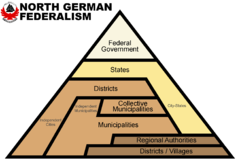
North German People's State
| Name | Purpose | Level |
|---|---|---|
| State | Federal state | First-level administrative division |
| District | Regional authority and governance | Second-level administrative division |
| Amt | Collective municipalities | Third-level administrative division* |
| Municipality | Municipal-level governance | Third-level administrative division |
| Regional | Sub-municipal governance | Fourth-level administrative division |
| District/Village | Ultralocal supervision | Fifth-level administrative division |
| *By common definition, technically inadequate application | ||
- The First-level administrative divisions are the 21 federal states, 5 of which are autonomous. The federal states take on similar responsibilities from those in the pre-collapse
 Federal Republic of Germany, while some autonomy, like school and electoral policy, has been either partially for fully stripped from these states in comparison to the FRG-era, the states do have more autonomy in other areas. Autonomous states are largely independent of the federal government in some aspects, however each of which has different regulations and rights/responsibilities.
Federal Republic of Germany, while some autonomy, like school and electoral policy, has been either partially for fully stripped from these states in comparison to the FRG-era, the states do have more autonomy in other areas. Autonomous states are largely independent of the federal government in some aspects, however each of which has different regulations and rights/responsibilities. - The Second-level administrative divisions are the districts, a regional authority which acts as a collection of municipalities, standing above municipal governments in administration but below state governments. These also take on similar tasks to their FRG-era equivalents, mostly retaining to things like vehicle registration, building and zoning regulations, data collection, and fund allocation. Unlike their FRG-era counterparts however, districts in North Germany are responsible for some economic planning.
- In North Germany, there are technically two administrative divisions commonly regarded as Third-level administrative divisions as per common international definition.
- The first one is the Amt a type collective municipality that serves as a cooperative union of several, often smaller, municipalities. Unlike most subdivisions in North Germany, this one serves little purpose as it has primarily been kept for traditional reasons, disregarding its lack of real function. Collective municipalities do not have a elected government, instead forming a small coordinative body that only meets rarely and serves primarily cultural, complaint, and cooperation purposes. This body is formed either through a collection of all mayors of the member municipalities, or through pulling a proportional faction percentage from all member municipality's councils.
- The second Third-level administrative division per definition are the municipalities, the most important subdivision in regular North German life. They serve as local governments; taking on municipal, cultural, and administrative tasks as well as some economic planning, zoning, and registration.
Municipalities always have a elected council governemnt and mayor.
- Fifth-level administrative divisions are this districts of cities, or villages of municipalities. These divisions always exist, primarily for historical and cultural purposes, however they can form district assemblies of either direct-democratic or elective nature in order to elect a ultralocal village representative and to create a space of public democracy which can most locally plan any developments, ideas, and to some extension, even economics. In some cases, it is possible for these village assemblies to overrule municipal decisions, however this rarely happens for important issues, and if it does, it often leads to a legal dispute. Such overruling is not possible for district assemblies in cities.
Every North German administrative division is guaranteed the right to secession via popular and democratic referendum as per the North German constitution.
List of States
The North German People's State has a total number of 21 federal states, 5 of which are autonomous - having more administrative freedoms.
Autonomous states are displayed in gold.
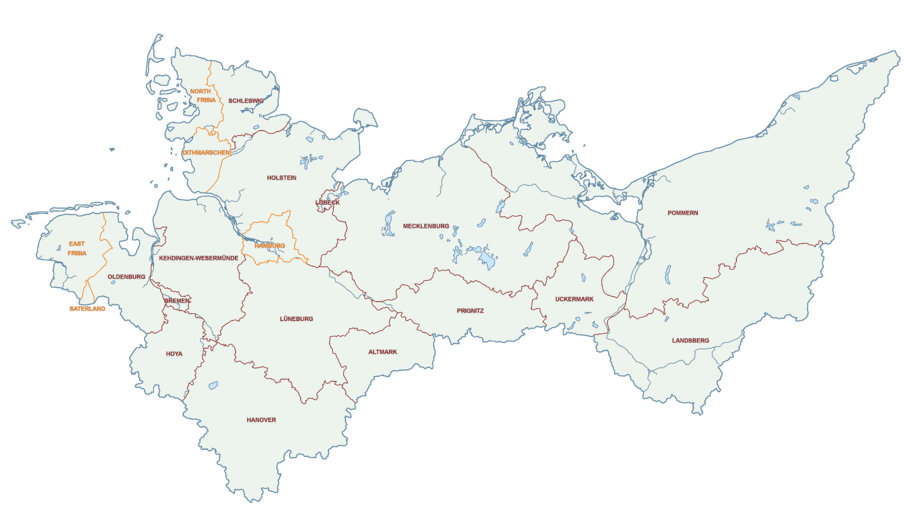
|
| Flag | Name | Code | Capital | Population | Leader |
|---|---|---|---|---|---|
 |
Altmark Altmark |
AL | Salzwedel | 193,456 | TBD |
 |
Free Hanseatic City of Bremen Freie Hansestadt Bremen |
HB | Bremen | 342,725 | |
 |
East Frisia Ostfriesland |
EF | Leer | 254,892 | TBD |
 |
Peasants' State of Dithmarschen Bauernland Dithmarschen |
DI | Heide | 117,673 | TBD |
 |
Free and Hanseatic City of Hamburg Freie und Hansestadt Hamburg |
HH | Hamburg | 829,490 | TBD |
 |
Hanover State Land Hannover |
HA | Hanover | 1,311,438 | TBD |
 |
Holstein Holstein |
HO | Kiel | 1,265,276 | TBD |
 |
County of Hoya Grafschaft Hoya |
HY | Hoya | 332,714 | TBD |
 |
Kehdingen-Wesermünde Kehdingen-Wesermünde |
KW | Vörde | 435,491 | TBD |
 |
Landsberg State Landsberg |
LB | Landsberg an der Warthe | 400,875 | TBD |
 |
Free and Hanseatic City of Lübeck Freie und Hansestadt Lübeck |
HL | Lübeck | 229,273 | TBD |
 |
Lüneburg Lüneburg |
LU | Lüneburg | 523,134 | TBD |
 |
Free State of Mecklenburg Freistaat Mecklenburg |
MK | Schwerin | 1,045,801 | TBD |
 |
North Frisia Nordfriesland |
NF | Husum | 143,258 | TBD |
 |
State of Oldenburg Land Oldenburg |
OD | Oldenburg | 234,098 | TBD |
 |
March of Pomerania Mark Pommern |
PO | Stettin | 634,423 | TBD |
 |
Prignitz Prignitz |
PR | Pritzwalk | 220,355 | TBD |
 |
Saterland Saterland |
SD | Ramsloh | 19,546 | TBD |
 |
Free State of Schleswig Freistaat Schleswig |
SL | Schleswig | 312,352 | TBD |
 |
Uckermark Uckermark |
UK | Prenzlau | 102,675 | TBD |
Culture
North Germany is majority German.
Media
All media produced by the North German State and its subordinate authorities is released as the collective ownership of all North German citizen under a near-public domain in accordance with the 2027 Public Broadcasting Copyright law.
Public broadcasting

 Landsberg State
Landsberg StateNorth Germany's primarily source of media is via public broadcasters and their agencies. The central public broadcasting agency is the North German Broadcasting Agency (Norddeutscher Rundfunk), or NDR for short. It holds control over all national, and most regional television as well as Radio channels.
The NDR is state-owned and operated as a public broadcasting agency, while it does have to hold to certain standards, state politics and the elected government do not have any influence over public broadcasting in North Germany, and the channels understood to fall under this umbrella are fully neutral when it comes to national politics. In international politics, certain grand narratives do prevail in the broadcast, such as the evils of imperialism and the Americans; however these are attitudes reflected in the majority of the North German population anyways and fall on few critical ears, which is why even said narratives, though they are sometimes examined critically, are also viewed to be 'neutral' within the nation.
The NDR can be divided into the following categories:
- North German Broadcasting Agency
- NDR TV
- National TV channels (i.e. NDR)
- Regional TV channels (i.e. FrieslandTV)
- NDR Radio
- National Radio stations (i.e. NDR 90,3)
- Regional Radio stations (i.e. Radio Hamburg)
- NDR Inter-/Intranet
- FUNK (i.e. Politik Verstehen)
- NDR International
- International TV channels (Norddeutsche Welle)
- International Radio channels (Norddeutsche Welle)
- Others
- Some regional newspapers
- Some shows that are broadcasted elsewhere
- NDR TV
The NDR is owned 100% by the state, thereof 80% laying with the federal Government, and the rest with those regions in North Germany that have their own channels and/or subdivisions. The broadcaster's employees are supervised by a Workers' Council that is elected every 3 years.
Television

Main Article: PCBaller World/North Germany/Public Television
North German television is administered primarily by the central broadcasting agency, NDR. Some regional stations do exist (either managed by one person/family or a cooperative), but their broadcasting is strongly regulated and their range limited to a 10km radius.
The NDR administers the following channels:
- National
- NDR
- NDR Kids
- Nationalfernsehn
- Regional
- Pommern TV
- Hamburg 1
- FrieslandTV
- DithmarschenTV
Intranet and Internet
North Germany has restricted internet access, instead upholding a intranet of sorts to provide similar services to its citizen.
Music
North Germany has a rich and continuous culture of music, dating back to the recorded middle ages.
Music in North Germany is written, produced, distributed, and played in all kinds of styles, but usually one of the four main languages of the state. While the use of other languages in music is not forbidden, they are discouraged from production (but not import).
During the ![]() 2039 Eurovision Song Contest, North Germany presented the
2039 Eurovision Song Contest, North Germany presented the ![]() Low German song Ganz goot by
Low German song Ganz goot by ![]() Frisian artist Norma.
Frisian artist Norma.
North Germany usually represents the ![]() Low German language at the Eurovision Song Contest, due to the German language already being represented by the
Low German language at the Eurovision Song Contest, due to the German language already being represented by the ![]() Federal Republic of Germany (Beryist Germany).
Federal Republic of Germany (Beryist Germany).
State-sponsored music
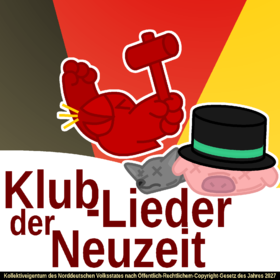
The North German state orchestra has been set up primarily to play the National Anthem (Lied vom Vaterland) as well as other official and state-related songs during ceremonies, parades, and other events.
It has since branched out however, most notably in the creation of the album "Klublieder der Neuzeit", which presents a collection of old Oktoberklub songs of which the lyrics were adjusted to fit the contemporary North German era; primarily emphasizing the nation, socialism, and culture.
The orchestra is also responsible to playing North Germany' military music.
The state orchestra has also worked with the DVJ (Democratic People's Youth) in the creation of a youth choir and band that writes, sings, and records; official, state, military, and cultural songs; similarly to the state orchestra itself.
Demographics
North Germany is majority German.
Ethnicity
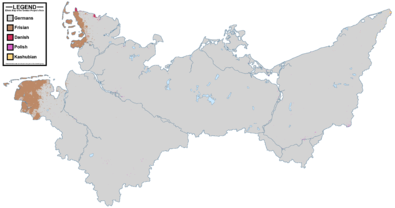
Citizenship
See also: North German Citizenship Law
| Citizenship | Population | % |
|---|---|---|
| 8,947,155 | 99.98% | |
| 805 | 0.009% | |
| 89 | 0.001% |
While dual-citizenship is officially banned in North Germany, there are however some cases in which the state has granted individual exceptions.
Most of these exceptions are given to diplomats and remnants of the Polish and Danish population, however some also have dual-citizenship with one of the bordering states due to having acquired it before North German independence and having legitimate interest in keeping it (such as living near the border).
There are very few people without North German citizenship living in North Germany as it is formally illegal to do so in most cases and a non-citizen is not offered any public services. Despite this, there are 89 people in residing in North Germany without possessing North German citizenship. 80 of which are refugees, 5 of which are children born without meeting the requirement for North German citizenship, 2 posses a working visa, and 2 are a special guests of the state.
While it is theoretically possible that there are more people without North German citizenship residing in the state, these would be illegal immigrants/residents, and are thus not recorded by the census and/or database.
Religion
| Are you part of a religious organisation? | % |
|---|---|
| 52.7% | |
| 42.3% | |
| 4% |
Language
| First Language | % |
|---|---|
| 98.6% | |
| 0.8% | |
| 0.4% | |
| 0.1% | |
| 0.1% |
| Second Language | % |
|---|---|
| 76.9% | |
| 4.1% | |
| 3.6% | |
| 1.4% | |
| 1.2% | |
| 1.1% | |
| 1% | |
| 0.6% | |
| 0.4% | |
| 0.2% | |
| 0.1% | |
| 0.1% | |
| 0.1% | |
| 9.2% |
| Language Proficiency | % |
|---|---|
| 99.9% | |
| 83.9% | |
| 7.2% | |
| 6.1% | |
| 3.6% | |
| 2.7% | |
| 2.1% | |
| 1.3% | |
| 1.2% |
Politics
Elections
For the last election, see: PCBaller World/North Germany/2035 North German federal election
The Parliament of the North German People's State is a primarily unicarmal house under a ![]() semi-direct democratic representative
semi-direct democratic representative ![]() multi-party system. The parliament is elected every 5 years by every citizen over the age of 16.
multi-party system. The parliament is elected every 5 years by every citizen over the age of 16.
Democratic People's Youth
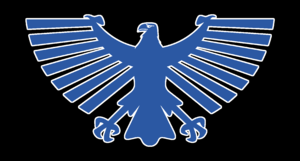
The Democratic People's Youth (German: Demokratische Volks-Jugend) is the North German political mass-movement aimed at encouraging democratic participation in the youth of North Germany as well as giving them a space to develop and discuss their opinions and ideologies. While the DVJ does not encourage a specific ideology, it rests itself on the principles on which the North German state was established; while most members agree to these principles, making it a de facto requirement for a functioning member, views that deviate strongly from the norm are allowed in the organization and can be put to the test in its environments.
The DJV is a way for young politically-interested North Germans to meet each other, form friendships, and discuss their ideas freely; while also partaking in many activities that are hosted free of charge. Membership in the DVJ is fully voluntary for those between the ages of 13 and 20, whereby the DVJ is split into two age groups: 13 to 15 & 16 to 20. These groups carry differentiating patches, but do not have any other separate insignia deviating from the DVJ logo and flag.
History of Political Parties
Iconography
Flag
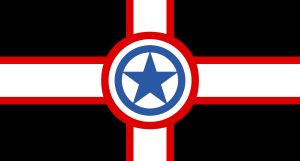
The flag of North Germany is inspired by that of the North German Confederation, using the same colours.
The symbolism of the North German flag's colours are as follows:
- Black - Black is the colour of Prussia, the state in which North Germany sees itself partially rooted and which first (mostly) unified the region which today makes up the North German state.
- Red - Red represents the Hanseatic League and the historical free cities of the north more broadly. It is rarely also interpreted as representing blood, this explanation however is not official.
- White - White represents the peace which North Germany seeks with the rest of the world and between its citizen. Additionally, it represents the purity of the national spirit.
- Blue - Blue represents to two seas which North Germany borders, having severely impacted North German history, economy, and culture; they are seen as a vital part of national identity.
The North German flag uses a cross to symbolize its northern heritage and closeness to the Nordic states (See: Nordic cross) both geographically, historically, and culturally. North Germany does not claim to be Nordic however.
Red and Black border each other in order to represent the reliance many free cities historically had on Prussia and its predecessor states, representing the need for the rural and agrarian to sustain the cities, while also showcasing a bit of regional history. The white color is enclosed by Red to symbolize that the free cities in historical times, were save guarding north German peace and purity.
In the centre of the flag is shown a star encircled, it represents the unity and closeness of the nation as a collective, enclosed by the state to protect it from outside evils.
History
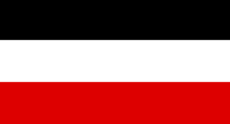
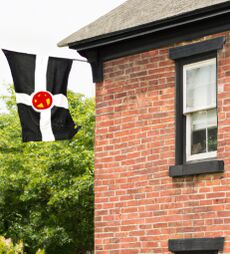
The flag was adopted on the 29th March 2026, only a few days after independence.
During the German Collapse and for the few days of independence without the official flag, North Germany used both it, the German Imperial flag (among other reasons in reference to the North German Confederation), and multiple other similar flags designed by individual people and tiny groups that fought for and/or supported North Germany.
| Flag | Usage and context |
|---|---|
 |
Flag of the German Democratic Movement, one of the first groups to call for North German independence. |
 |
Flag of the LNPD, the whole Northern section of which supported the North German Movement. |
 |
Flag used by the North German Tinists, most of which supported the North German Movement. |
 |
Multiple state and regional flags were used within the North German movement, the flag of Mecklenburg was used especially often due to Mecklenburg's strong protest and patriotic culture. |
 |
Flag used by protestors in northern Germany, many of which joined the North German Movement. |
 |
Flag used by protestors in northern Germany, many of which joined the North German Movement. |
 |
Versions of the flag of the historical Rural People's Movement, which has often seen use by nationalist farmers in northern Germany, were used during the German Collapse by farmers that supported North Germany. |
 |
Flag of the collective Separatist Alliance, which the North German Movement was a part of. |
 |
Flag of the German Democratic Republic, used by some supporters of the North German movement. |
 |
Flag of the PKZADBNUWN, a Polish support group of North German liberation. |
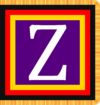 |
Personal Standard of |
 |
One of the early versions of the modern North German flag that was used by militants supportive of the North German Movement. |
 |
Flag of the Pomeranian Condominium (Transitional State of Pomerania) established after the Treaty of Zgorzelec (2027-2028) |
Coat of Arms

The current North German Coat of Arms was drawn up by the Emergency Iconography Commission at independence due to a lack of official Coat of Arms or seal for the time of deceleration. While officially being temporary, there is nothing more permanent than a temporary solution; thus North Germany has come to experience as well since it has not changed its Coat of Arms as originally intended.
The Coat of Arms showcases a Red eagle; it represents the German nation (continuously represented as an Eagle thought history) as well as northern Germany's Prussian history and the state of newly regained Pomerania as a sign of pride. The colour of the eagle is red; it represents the Hansa as well as the blood of those that fought for the nation. The eagle spans it wings wide, encircling the central Valknut and displaying its might.
The Valknut, the central party of the Coat of Arms, is representative of the northern German and Germanic peoples as an ancient symbol of the area. Additionally to representing the nation, it also represents a longing for return to nature and a simpler life, perhaps even Germanic Paganism.
Below the Symbols is a ribbon stating the name of the country - Norddeutscher Volksstaat (North German People's State).
Atop the eagles wings is written the Motto of the state - "Frieden, Freiheit, Volk, Naturverbundenheit", roughly translating to "Peace, Freedom, Nation, and connection to nature".
Diplomacy
North Germany is a generally neutral and isolationist state, wanting to involve itself little in the conflicts and disputes of the world, but rather just try to be left alone.
Despite this however, North Germany has a clearly east European allegiance, primarily with ![]() Poland, with which North Germany maintains very good relations, and some of its allies. North Germany holds strained relations with Sorbia due to their strong anti-German sentiment and constant threatening of war.
Poland, with which North Germany maintains very good relations, and some of its allies. North Germany holds strained relations with Sorbia due to their strong anti-German sentiment and constant threatening of war.
North Germany is a strongly anti-American state, opposing ![]() Greater Illinois and practically all its actions, as well as strongly opposing any move towards American reunification. North Germany views the American collapse is as one of the greatest events in recent history.
Greater Illinois and practically all its actions, as well as strongly opposing any move towards American reunification. North Germany views the American collapse is as one of the greatest events in recent history.
North Germany is a member state of the ![]() AltUN and the
AltUN and the ![]() Nationalist International, as well as being a founding and leading member of the
Nationalist International, as well as being a founding and leading member of the ![]() UFNNS.
UFNNS.
Diplomatic missions
| Country | Relations established | Ambassador from North Germany |
Ambassador to North Germany |
|---|---|---|---|
| ICELANDIC | |||
| WIP | EUROPEAN | ||
| WIP | SWEDISH | ||
| INDONESIAN | |||
| ILLINOISIAN |